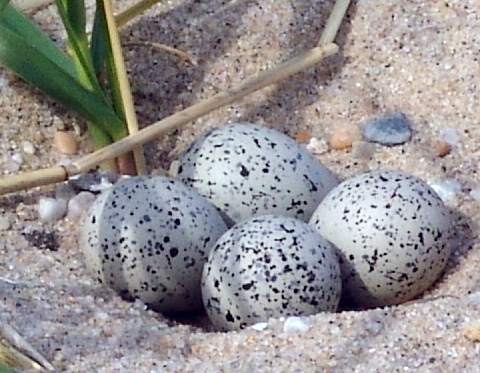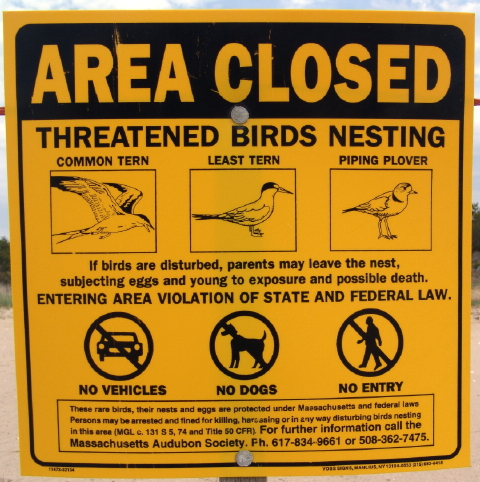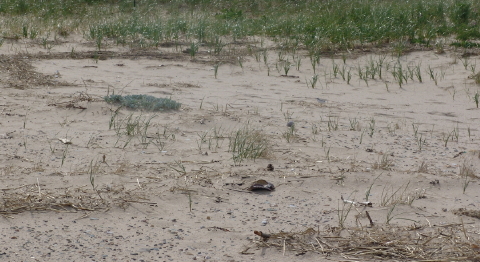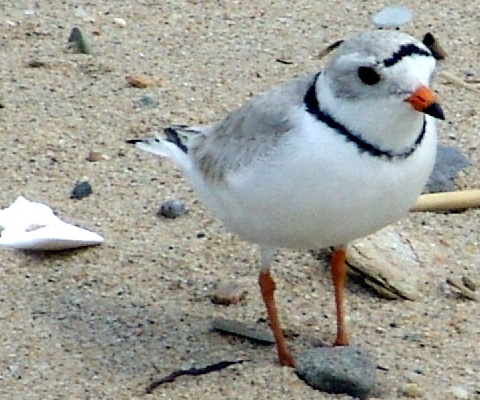Piping Plover (Charadrius melodus)Â
During Saturday’s terrapin sampling on Outer Cape Cod, Turtle Journal encountered an active piping plover (Charadrius melodus) nest that has been protected by symbolic fencing and a nest exclosure by Mass Audubon. These tiny birds have been pushed to the brink of extinction by pressure from human activities in their nesting zones. Summer cottages, off road vehicles, dog walking, nature hikes and all manner of recreational and commercial activities that occur within the fragile shoreline that plovers must use for nesting each year create enormous challenges for these tiny creatures.Â
Four Perfect Piping Plover Eggs
Even without the added pressure of humans, piping plovers have a tough time. Eggs are exposed to the elements in shallow scrapes bare and uncovered by anything except a protective plover parent. When parents are disturbed from the nest because of human activites, the eggs can … depending on temperature … be lost or delayed in development. Spring tides overwash nests with regularity, especially in areas that have been sand-starved because of human development along the coastline. Predators relish plover eggs and these tiny birds are helpless to ward off animals that dominate them in size and power. Plover parents courageously feign a wounded wing or do whatever they can to tempt the predator to pursue them rather than find the vulnerable eggs.
Piping Plover Guarding Protected Nest
Because plovers must nest in our cherished summer recreational spots, they become the object of anger when they interfere with human sport or enterprise. “Plovers taste like chicken” has become the mantra of frustrated individuals and groups who have been affected by restrictions to protect threatened plovers. The dynamics are not pretty. Beyond inconvenience, plover regulations can cut into revenues and for towns that depend overwhelmingly on summer tourism, losing weeks of spring and summer to plovers can create a huge economic impact. All sides have valid arguments and complaints, yet for the plovers, the situation is literally life or death.
Signs Alert Public to Sensitive Plover Nesting AreasÂ
Mass Audubon, among other environmental and conservation organizations, assist state and federal authorities in protecting plover nests. They post signs to alert the public to nesting pairs, they erect symbolic fencing to keep humans (and pets) from intruding into nesting grounds, and they install nest excluders over the eggs. These excluders allow the plover parents to reach the eggs, but keep out larger predators. Still, the symbolic fencing and excluders cannot keep out flood tides nor can they prevent powerful and aggressive predators from overwhelming these defenses.
Find the Piping Plover
Plovers are so small and camouflaged that they are extremely elusive and difficult to spot. (Click on the photograph above to find the plover.) Their eggs, too, blend in naturally with the beach surroundings. While these facts help protect plovers and their eggs from predators, we can easily stumble into a new plover nesting zone without signage to warn us. If you do spot a nest that has not been marked, call Mass Audubon at the numbers listed on the sign above to alert them and to protect the plovers.
Tiny Piping Plovers Need Our Help to Survive
Plovers need our help to survive. Despite inconvenience, plovers are an important element of the native Cape Cod habitat and experience. They deserve our respect and protection.




